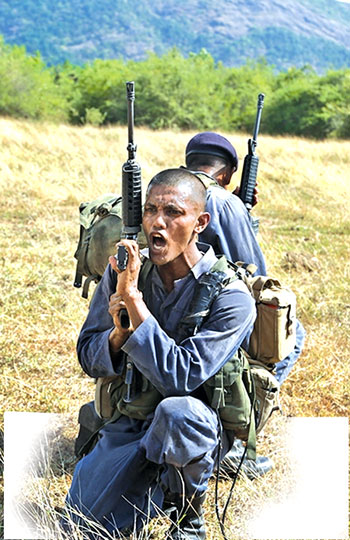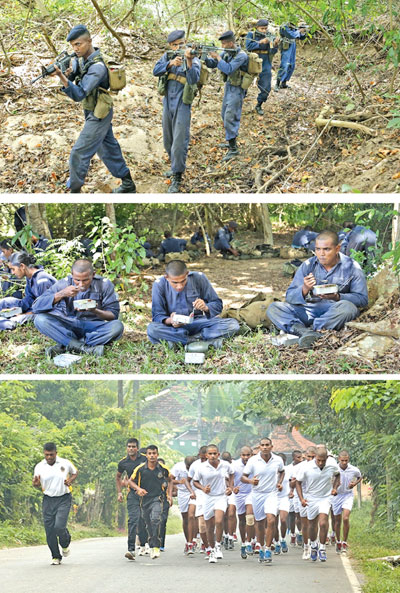
As the commander’s guttural voice cracked, the trainees stood in. I stood along with the other young men trying to adjust my mind and body to take the most difficult challenge before me; that is to go through a two-day training program at the Special Task Force Training School at Katukurunda, Kalutara.
 To me the most significant moments were at the firing range: realizing that a single bullet can take away a life in a fraction of a second.
To me the most significant moments were at the firing range: realizing that a single bullet can take away a life in a fraction of a second.
That is not to say I regret going through this two-day training session, which only gave me insight into the six-month basic training course. I saw first-hand why the young, brave men from around the country have joined the Special Task Force to play a major part in defending our country. It also taught me that with power comes greater responsibility. Katukurunda impressed in me that we must always sustain peace.
I was met on arrival by the Director, Superintendent of Police, Athula Daulagala (MSc) and Chief Inspector, Gihan Gunaratne. During the inception, the British SAS (Special Air Service) trained 9 intakes and since then the local staff have produced up to 73 intakes.
After a recruit enters the school his educational certificates are verified along with other documents. He is paired with a “buddy” – another recruit. I receive a camp orientation from SI Dilshan Kudahetty, getting to know the armoury, stores, library, gym, swimming pool, firing range , parade ground, mess (meal hall), hospital, salon, admin office, temple and accommodation billets.
The entire compound is set on 65 acres of land that has a mix of terrain from jungle thickets, rock formations and fields. First stop is at the stores where Sub Inspector Walter issues a blue drill overall, boots and blue beret. This is accompanied by a mess tin (utensil to eat), a poncho (military rain coat), back pack, rope and ground sheet.
My first briefing is from Inspector Abeysinghe. His task is to make the recruits understand the history of the STF, law and its implications, the court systems, the Evidence Ordinance and criminal proceedings. My second task is with Sub Inspector A.M.S. Rajitha, who is armed with three academic degrees and has the muscle displacement of a gladiator. He teaches recruits to use the compass and GPS (Oregon 650) systems and read maps which are vital for reconnaissance.
Scorching sun
He inspires the young men and women to stay motivated through team building. I am given advice on the importance of a nutrition enhanced diet as I would burn 2,500 calories per day. At boot camp tea is served at 5.30 am, after which a range of physical training is carried out. A glass of milk is given at 8 am. Breakfast is at 8.30 am. Theory is done in classrooms until 12.30 pm and we adjourn for lunch. The next break is at 3.30 pm for tea and after a rigorous day on the field in the scorching sun, dinner is a refreshing meal dished out at 7.30 pm. At 9 pm a roll call is done by the platoon OIC to ensure that we have all survived the day!
The next segment is probably the most crucial part for any recruit, learning the lessons of tactics. Tactics are crucial to achieve a given mission objective. Tactics also include field craft: the way of moving in the jungle as an effective platoon. I am taken into the dense foliage by Sub Inspector L.H. Silva a tracker who helps me to blend in with the mosquito infused environment.
I am now part of a 6 man foot patrol moving with caution. At the helm is the lead scout who always maintains a 160 degree field of vision. He must remain alert using hand signals to caution the others. The second is the cover man: he has to provide cover to the scout. The section commander is in position 3, followed by the communicator who carries a Cougar man pack VHF radio. He relays real time feedback to the base. Behind me is the medic who is flanked by the last man on the team who carries a light machine gun. The heat and mosquito stings test your patience. Jungle training is carried out for 14 days. Aspiring commandos are taught Heli – drill. You master the basics on how to board and exit a helicopter.
 At the end of this exercise we are joined by Chief Instructor CI Gihan who explains the technique of “harboring”- which is a position of resting. A poncho (raincoat) is spread on the ground. A second poncho is attached on top using a rope. This makes a tent like shelter where two can take a rest as 2 others stand on sentry duty concealed by the trees and wild creepers. Returning back to the admin block I meet up with Sergeant Ratnayake, Drill Instructor. He teaches me to salute. It is the role of the DI to maintain total discipline. They also muster recruits to march in formation. At 1700 hours I head to the 300 metre firing range. I had anticipated this earnestly. I recognize the face of award winning marksman Inspector Divulwewa, Weapons Instructor. He emphasizes the need for safety at all times.
At the end of this exercise we are joined by Chief Instructor CI Gihan who explains the technique of “harboring”- which is a position of resting. A poncho (raincoat) is spread on the ground. A second poncho is attached on top using a rope. This makes a tent like shelter where two can take a rest as 2 others stand on sentry duty concealed by the trees and wild creepers. Returning back to the admin block I meet up with Sergeant Ratnayake, Drill Instructor. He teaches me to salute. It is the role of the DI to maintain total discipline. They also muster recruits to march in formation. At 1700 hours I head to the 300 metre firing range. I had anticipated this earnestly. I recognize the face of award winning marksman Inspector Divulwewa, Weapons Instructor. He emphasizes the need for safety at all times.
Criminal mind
The range is well buffered by a hill formation on three sides. Recruits do practice “dry” runs of loading a T-56 rifle. A firing squad of six demonstrates with live ammunition. As the bullets hit the targets they send sparks and a mild ricochet. One must be able to shoot accurately from 3 positions: prone, kneeling and standing. Additional firing is done in the jungle training segment. At 2030 hours we end the day. Feeling tired.
After breakfast on day 2, I enter the classroom of the Explosives Branch. Sub Inspector P.R.S Bandara teaches me the basics of searching a human, a room and a vehicle. It is indeed fascinating to note how a criminal mind can desire to hide things. He teaches recruits the impact of various exploding devices from a hand grenade to a claymore mine. The next lesson is with IP Kulathunga who has a black belt in both karate and taekwondo. He imparts his knowledge on first aid and communication. Both these subjects are vital, especially, when sent on a danger laden mission. After 2 months at the training school having enhanced their fitness and mobility, trainees are put to the Assault Obstacle Course, which has 15 formidable challenges.
It starts with jumping from a ramp, mounting a 6 foot wall, dangling on an iron monkey ladder, crawling in and out of a tunnel, swinging on the Tarzan rope, step up, crawling under razor sharp barbed wire, climbing onto a net, walking on the trapper lines, stepping with speed on swinging logs, a 90 degree “Iguana” wall and finally, a jump across a 9 foot wall.
As the course progresses this has to be done carrying your personal rifle. An exhausting engagement. Commandos learn the art of abseiling and rappelling using ropes and metal harnesses from a 54 foot tower, a test of endurance. On completion of 6 months the recruits take part in a pass out parade and finally, get the coveted Green Beret and the green uniform.
They have been tried and tested. After my brief training I was certainly challenged physically and mentally. The exertion of the body is geared to build endurance and stamina.
The human mind and will power is pushed in a manner which will sharpen your thinking, and decision making. Team work is key to achieve solid results. To me the most significant moments were at the firing range: realizing that a single bullet can take away a life in a fraction of a second .It also taught me that with power comes greater responsibility.
Katukurunda impressed in me that we must always sustain peace. The transformation of a recruit into an STF warrior is a magnificent journey of determination. It is best captured in the words of the late Special Task Force DIG Upali Shahabandhu who often said “Think special, Act special ”.
